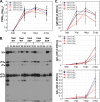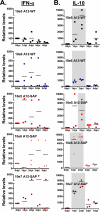Inoculation of swine with foot-and-mouth disease SAP-mutant virus induces early protection against disease
- PMID: 22114339
- PMCID: PMC3264347
- DOI: 10.1128/JVI.05941-11
Inoculation of swine with foot-and-mouth disease SAP-mutant virus induces early protection against disease
Abstract
Foot-and-mouth disease virus (FMDV) leader proteinase (L(pro)) cleaves itself from the viral polyprotein and cleaves the translation initiation factor eIF4G. As a result, host cell translation is inhibited, affecting the host innate immune response. We have demonstrated that L(pro) is also associated with degradation of nuclear factor κB (NF-κB), a process that requires L(pro) nuclear localization. Additionally, we reported that disruption of a conserved protein domain within the L(pro) coding sequence, SAP mutation, prevented L(pro) nuclear retention and degradation of NF-κB, resulting in in vitro attenuation. Here we report that inoculation of swine with this SAP-mutant virus does not cause clinical signs of disease, viremia, or virus shedding even when inoculated at doses 100-fold higher than those required to cause disease with wild-type (WT) virus. Remarkably, SAP-mutant virus-inoculated animals developed a strong neutralizing antibody response and were completely protected against challenge with WT FMDV as early as 2 days postinoculation and for at least 21 days postinoculation. Early protection correlated with a distinct pattern in the serum levels of proinflammatory cytokines in comparison to the levels detected in animals inoculated with WT FMDV that developed disease. In addition, animals inoculated with the FMDV SAP mutant displayed a memory T cell response that resembled infection with WT virus. Our results suggest that L(pro) plays a pivotal role in modulating several pathways of the immune response. Furthermore, manipulation of the L(pro) coding region may serve as a viable strategy to derive live attenuated strains with potential for development as effective vaccines against foot-and-mouth disease.
Figures








References
-
- Aravind L, Koonin EV. 2000. SAP—a putative DNA-binding motif involved in chromosomal organization. Trends Biochem. Sci. 25: 112–114 - PubMed
-
- Balabanian K, et al. 2002. Interleukin-10 modulates the sensitivity of peritoneal B lymphocytes to chemokines with opposite effects on stromal cell-derived factor-1 and B584 lymphocyte chemoattractant. Blood 99: 427–436 - PubMed
-
- Bautista EM, Ferman GS, Golde WT. 2003. Induction of lymphopenia and inhibition of T cell function during acute infection of swine with foot and mouth disease virus (FMDV). Vet. Immunol. Immunopathol. 92: 61–73 - PubMed
-
- Becker Y. 1994. Need for cellular and humoral immune responses in bovines to ensure protection from foot-and-mouth disease virus (FMDV)—a point of view. Virus Genes 8: 199–214 - PubMed
Publication types
MeSH terms
Substances
LinkOut - more resources
Full Text Sources
Other Literature Sources
Research Materials
Miscellaneous

